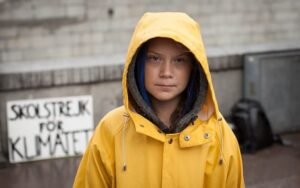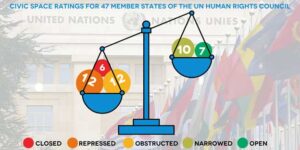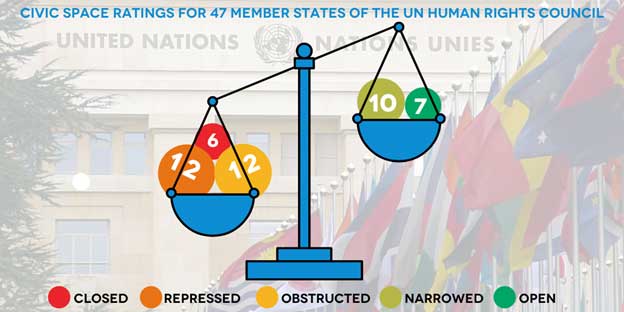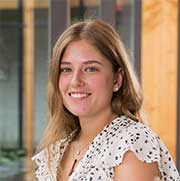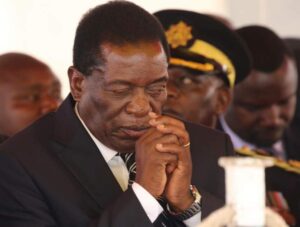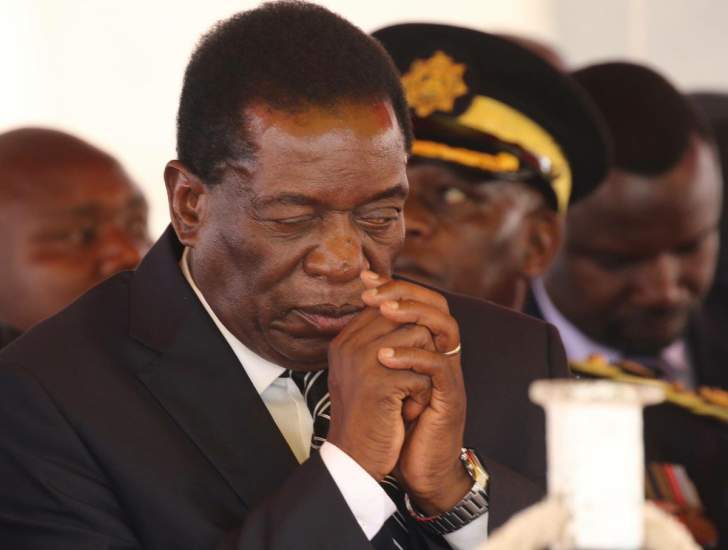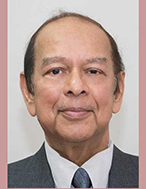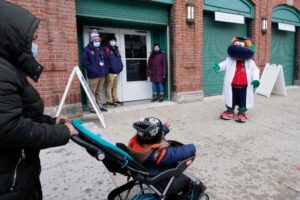

With the pandemic slowly receding, governors around the United States are beginning to relax restrictions meant to curb the spread of the coronavirus.
But the rules ae being eased much the same way as they were imposed: in a patchwork fashion that largely falls along party lines. Republicans are leaning toward rollbacks and Democrats are staying the course or offering a more cautious approach.
On Thursday, Gov. Greg Abbott of Texas said he was considering lifting a statewide mask mandate, which has been in place since July.
“We’re working right now on evaluating when we’re going to be able to remove all statewide orders, and we will be making announcements about that pretty soon,” Mr. Abbott said.
Mr. Abbott, a Republican, has been scrutinized for his handling of the pandemic, especially given the runaway infection rates in his state’s border cities. In November, he ruled out “any more lockdowns,” determined to keep Texas open despite a surge in cases.
As Mr. Abbott weighs easing restrictions, the state’s vaccination effort has yet to fully rebound from the winter storm that knocked out power to millions and crippled water systems across Texas last week, as it has in other parts of the country.
According to a New York Times database, 11.7 percent of Texas’ population have received their first of two shots and 5.4 percent have been fully vaccinated. Nationally, 14 percent of the population have received their first doses. Texas is one of four states in the country to have vaccinated under 12 percent of its population (the others are Georgia, Tennessee and Utah).
In Mississippi, Gov. Tate Reeves said he was also considering pulling back some restrictions, particularly mask mandates for those who have been fully vaccinated. Just over 12 percent of the state’s population has received at least one shot and 5.5 percent have received both.
But in Mississippi and elsewhere, even as a mass vaccination campaign continues to pick up momentum, new dangers loom in the form of more contagious coronavirus variants. The variants might cause new spikes in infections that outpace the gains made by vaccination. So could lapses in social distancing and other precautions.
In Massachusetts, Gov. Charlie Baker, a Republican who has been criticized for a rocky vaccine rollout, announced Thursday that the state would move into the next phase of reopening in March as long as infection rates continue to trend downward. Capacity limits for indoor dining will be lifted starting next week, but bars and nightclubs will remain closed.
Large sports facilities like Fenway Park, Gillette Stadium and TD Garden can reopen at 12 percent capacity starting March 22, he said.
“We’ve been watching how these venues perform in other states and believe with the right safety measures in place they can operate responsibly and safely here in the commonwealth,” Mr. Baker said.
Red Sox opening day is scheduled for April 1 at Fenway.
In Philadelphia, Health Commissioner Thomas Farley said he, too, was “optimistic” that there would be some fans in the stands for the Phillies’ opening day.
On Wednesday, Gov. Roy Cooper, a Democrat, announced some changes to Covid-19 restrictions in North Carolina, eliminating the state’s nightly curfew and easing occupancy regulations at indoor and outdoor businesses.
The Republican-led North Dakota House of Representatives went a step further, passing a bill on Monday that would prohibit state and local governments from creating mask mandates in the future. The bill is headed to the State Senate.
The bill’s sponsor, Representative Jeff Hoverson, said during a radio interview that he questioned the effectiveness of masks, and wanted to preserve people’s individual freedoms.
Gov. Doug Burgum allowed the state’s mask mandate to expire in January.
Some Democratic leaders are taking more measured steps.
In Virginia, Gov. Ralph Northam said he was easing limits on outdoor gatherings and ending a 12 a.m. to 5 a.m. curfew starting Monday; restaurants and bars will be permitted to serve alcohol until 12 a.m.
“We hope that with trends continuing as they are, that we can look at further steps in the coming months,” Mr. Northam said Wednesday. “But it’s critical that we do this slowly and thoughtfully.
Gov. Gretchen Whitmer of Michigan said at a news conference on Wednesday that she also planned to ease some restrictions “in the coming days,” though she provided few specifics.
“Our case numbers and public health metrics are trending in the right direction,” she said. “I’m very pleased to see that, and feeling very optimistic.”
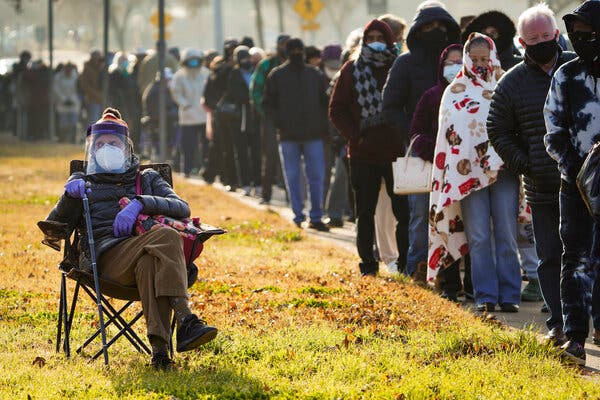
Reports of new vaccinations have started to increase again across the United States, after a week of declines brought on by severe weather.
The country administered an average of about 1.5 million newly reported doses a day in the seven-day period ending Thursday, according to federal data, a slight increase from a low point of 1.4 million doses a day through Tuesday.
The Centers for Disease Control and Prevention reported Thursday that nearly 68.3 million doses of vaccine had been administered across the country since the U.S. vaccination campaign began in December. Since Jan. 20, the C.D.C. has reported that more than 50 million shots have been administered across the country.
But even as the pace of vaccination rebounds, it remains well below the roughly 1.7 million doses the country was averaging each day before a powerful winter storm disrupted shipping nationwide last week and forced vaccination sites to close in parts of the South and Midwest.
The average number of daily doses administered across the country had been steadily increasing as the two federally authorized vaccine manufacturers, Pfizer and Moderna, became more efficient and expanded production for their two-dose vaccines.
While that acceleration had been expected well before President Biden assumed office, officials have been anxious to highlight every increase in shipments as evidence that the new administration is fiercely battling the pandemic. A third vaccine, from Johnson & Johnson, which is a one-dose vaccine, is expected to be authorized soon.
On Thursday, Mr. Biden watched two firefighters and a Safeway grocery store manager get vaccinated at an event in Washington, and used the moment to mark the nation’s progress toward goal — considered fairly unambitious by many many experts — he set before he took office: 100 million shots in his first 100 days.
“We’ve been laser-focused on the greatest operational challenge this country’s ever undertaken,’’ he said, taking a shot at his predecessor, Donald J. Trump. “We are going from a mess we inherited to moving in the right direction,’’ he said.
At one point, Mr. Biden suggested without specifics that in late April or May there may be more vaccines available than people willing to take them.
“We’re gong to hit a phase in this effort, maybe as late as April or May, when many predict, instead of long lines of people waiting to get a shot, we’ll face a very different scenario, we’ll have the vaccine waiting,” he said.
The president’s optimism about supply tracks with congressional testimony from vaccine manufacturer officials earlier in the week. Pfizer and Moderna executives testified at a congressional hearing that they would deliver a total of 400 million doses by the end of May, and a total of 600 million by the end of July. Johnson & Johnson has pledged 20 million doses by the end of March and 100 million doses by the end of June, if its shot is authorized.
But on Thursday, Mr. Biden repeated his warning that “this is not a victory lap” and said he could not predict when life might return to normal.
With plans to distribute more doses in the weeks ahead, states have moved to expand eligibility to additional high-risk groups. But unlike in the early days of the vaccine campaign, when many states limited doses to medical workers and nursing home residents, a complex patchwork of rules has emerged from state to state and even county to county.
People 65 and older are eligible for vaccines in most states, but a handful of states still limit vaccines to those who are at least 70 or 75. At least 45 states have also expanded their occupation-based vaccination programs to include some nonmedical workers, such as police officers or grocery store workers, though the list of eligible professions varies widely. At least 32 states are allowing some teachers to get shots.
Many states have offered vaccines to adults with certain high-risk medical conditions, but others have decided to focus for now on their oldest residents. Gov. Tim Walz of Minnesota said Thursday that eligibility would not be further expanded in his state until at least 70 percent of residents 65 and older had been vaccinated, a goal he hoped to reach by the end of March.
“Older Minnesotans have borne the brunt of the Covid-19 pandemic and we are focused on making sure they get vaccinated and keeping them safe,” Mr. Walz said in a statement. “These vaccines work — we can see that in the plummeting cases, hospitalizations, and deaths in long-term care facilities around our state.”
Sharon LaFraniere contributed reporting.
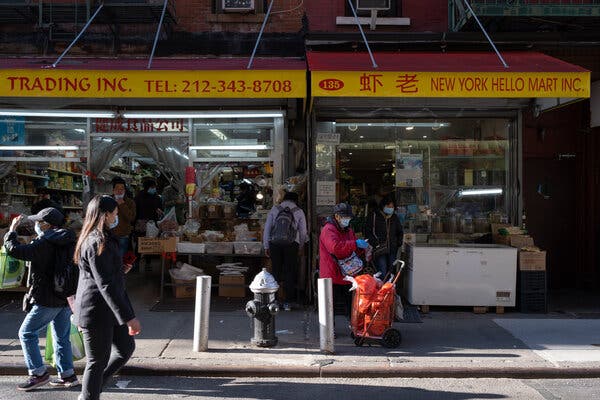
As the rate of positive coronavirus test results and the number of virus cases have trended downward to pre-holiday levels, Gov. Andrew M. Cuomo has reopened a spigot of activity in New York: indoor dining at reduced capacity in New York City, major sports stadiums and arenas with limited fans, movie theaters in the city and wedding venues.
But virus variants, including a new form spreading in New York City, could pose threats to the city’s progress. Mr. Cuomo said he did not want to keep things closed just because the variants were here.
“On a daily basis we are looking at the data and calibrating this,” said Gareth Rhodes, a member of Mr. Cuomo’s coronavirus state task force. “You have to be very, very careful, but also recognize that you cannot keep the economy indefinitely closed.”
But experts noted that, with the arrival of the variants, keeping community transmission at bay is more important than ever.
“It does not make epidemiologic sense to me,” said Dr. Denis Nash, an epidemiologist at the City University of New York. “I see how it makes economic sense, on the one hand. In the short term, it will help the bottom line of restaurant workers and employ people. But it also puts employees at risk, and it is at cross purposes with the larger goal, which is to get the vaccine into as many arms as possible before the virus gets them.”
New York City has seen a steep decline in the number of people testing positive for the virus each day, but the drop has not been as dramatic as it has been nationally and community transmission in the city remains high.
One encouraging sign is that there has been a steeper drop in the positive test rate among New Yorkers over 75 than in New Yorkers as a whole, likely because of vaccinations. Also, emergency room admissions for people over 65 have stabilized and are falling gradually.
As of Tuesday, the city had partially or fully vaccinated about 1 million people — a major milestone for the rollout. Of those, about half a million people had received both shots.
But the vaccine rollout has been uneven across racial groups, with those hit hardest by the virus being vaccinated at lower rates. Though nearly one-quarter of New Yorkers identify as Black, for example, Black people account for only 12 percent of the vaccinations, according to city statistics.
In addition, about a quarter of the people who have been fully vaccinated in New York City do not live in the city, but outside it, according to the data. It is unknown how many qualified because they work in the city or were vaccinated at state sites, and how many broke the rules.
The pace of vaccination in recent days has also been slower than the city would like, as delivery delays caused by bad weather compounded shortages in supply. In the past week, the city has administered about 30,000 vaccines a day, down from a peak of 60,000 doses per day the prior week.

ABOARD U.S.S. NIMITZ, off California — Many Americans might have given almost anything to have escaped the past year in their country, but consider the experience of the crew of the Nimitz.
When the aircraft carrier departed Naval Base Kitsap in Bremerton, Wash., on April 27, George Floyd was still alive. Donald J. Trump was still president. Georgia had two Republican senators. And some 56,000 people in the United States had died of the coronavirus.
Now, 10 months later, the nuclear-powered warship is returning home to a country vastly different from the one it left. That difference was highlighted on Thursday when the new defense secretary — for the first time, an African-American — landed on board to talk to a travel-weary and isolated crew.
“Secretary of defense in combat!” came the announcement.
Lloyd J. Austin III, his baritone ringing through the ship’s public-address system, told the sailors and pilots on the Nimitz that he knew what it felt like to be cut off from life during extended deployments: Mr. Austin, a retired Army four-star general, was posted in Iraq about a decade ago for a tour even longer than the Nimitz’s.
But that was on land, in Army bases near Baghdad and flying around to Erbil and Ramadi. The Nimitz sailors and Navy and Marine pilots were at sea, spending 2020 in what sometimes felt like a time capsule, sailors said.
They had to quarantine for two weeks before they even boarded the ship and, once on, they basically could associate only with one another, even during port calls.
On the rare occasions that the ship came into port — in Guam or in Manama, Bahrain — the 5,000-strong crew was not allowed traditional shore leave, and had to sleep on board, in berths with around 100 other sailors. They were told not to interact with the public on land, because of the pandemic.
They watched the presidential election returns from the Indian Ocean and woke up the morning of Jan. 7, in the Persian Gulf, to the news that rioters had stormed the Capitol.
Among crew members on Thursday, there was a palpable sense of excitement, but also some trepidation about what they would find after 10 months in a bubble at sea.
Some had lost family members to Covid-19 — after all, more than 450,000 morel people in America had died of the disease while the Nimitz was sailing the world.
Petty Officer First Class Christina Ray, 31, said she was hopeful — but wary.
“I am filled with so many emotions,” she said. “We’ve been so removed from the world, and now it’s like, ‘How do I be normal?’”
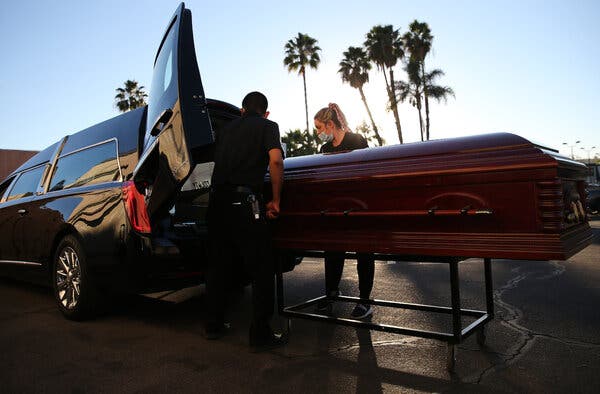
“It’s really hard to put all of it into words.”
It was December, as Covid-19 deaths were besieging California, and Helen Cordova, an intensive care unit nurse in Los Angeles, was trying to describe what it was like.
“This is a very real disease,” Ms. Cordova said. “Those images of inside of hospitals, that’s very accurate.”
Two months later, it is still hard to put in words how deeply the pandemic has scarred the state, but one single number told the story: 50,000.
That is how many people have died from coronavirus over the past year in California — the first state to pass that milestone. The record was hit on Wednesday, and by Thursday deaths were nearing 51,000.
It was a bleak reminder that the recent progress the state has made against the pandemic may be fragile. Most of those deaths were recorded recently, during a frightening winter surge that followed a period of relatively low case counts and cautious hope.
According to a New York Times database, California, the country’s most populous state, averaged more than 560 deaths a day at its peak in January. By contrast, for much of November, it reported fewer than 50 deaths a day on average.
Though the state has reported more total deaths than any other in the nation, it is far from the hardest hit relative to the size of its population. At least 30 states have reported more total deaths per capita, and New Jersey has recorded twice as many.
Tallying the loss of life across California’s vast expanse belies the virus’s uneven impact on poorer communities of color, particularly in the Central Valley and Los Angeles.
“We’ve created a separate and unequal hospital system and a separate and unequal funding system for low-income communities,” said Dr. Elaine Batchlor, chief executive of Martin Luther King Jr. Community Hospital in Los Angeles, the hardest-hit hospital for its size in the hardest-hit county in the state.
Latinos, who are more likely than other Californians to work in essential industries and less likely to have the resources or space to isolate themselves if they get infected, have been sickened and have died at disproportionately high rates.
And so far, California has failed to prevent the same inequities from plaguing the state’s vaccination effort, a process that has been criticized as chaotic and confusing.
Nearly all of California’s roughly 40 million residents spent the holidays under strict orders to stay at home. Gatherings with people they did not live with were banned.
Even with those restrictions, the virus spread rapidly and hospitals were overwhelmed.
Doctors and nurses like Ms. Cordova treated patients in hospital lobbies. Relatives watched remotely as loved ones took their last breaths. Health care workers who held the screens for them are still grappling with the lingering effects of sustained trauma.
Now, as in the fall, there is a feeling of hope.
California is reporting half as many new cases a day, on average, as it did two weeks ago. Some counties have been allowed to lift restrictions, and local officials say more reopenings are on the way.
And California has administered many more vaccine doses than any other state.
The first in the state to get one outside of a clinical trial?
Ms. Cordova.
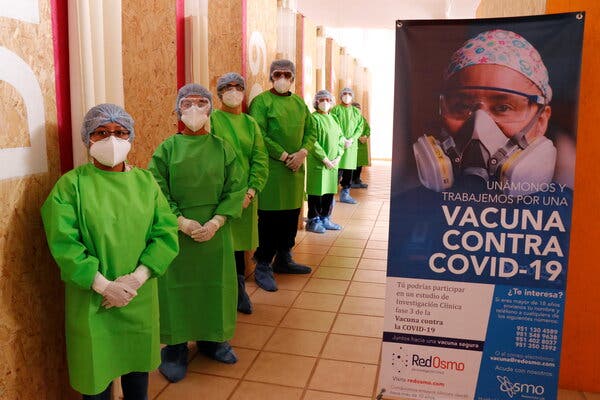
China has approved two Covid-19 vaccines whose manufacturers say are effective at preventing serious illness, paving the way for their deployment in the country and the developing world over the next few months.
China now has four vaccines approved for general use; two are already being mass produced, by the companies Sinopharm and Sinovac Biotech. The addition of two more could significantly speed up China’s strategy of vaccine diplomacy and its mass domestic inoculation drive, which has been slow in part because the government is prioritizing the export of its vaccines.
All four vaccines have been shown to prevent severe illness, but they have been dogged by a lack of transparency around clinical data.
CanSinoBIO, which has teamed up with a military institute that belongs to the People’s Liberation Army, said this week that its one-shot vaccine had an efficacy rate of 65.28 percent at preventing all symptomatic Covid-19 cases. Separately, Sinopharm, a state-controlled company with a vaccine that is already in use in China, said the shot that it developed with its affiliate, the Wuhan Institute of Biological Products, had an efficacy rate of 72.51 percent.
The companies gave few details on their analyses, such as how many people contracted Covid-19 during the trials. That will make it hard for scientists to evaluate the new vaccines independently.
Several developing countries have already ordered the two new vaccines, which can be easily stored at refrigerated temperatures.
Like other Chinese vaccine makers, CanSino had to start its Phase 3 clinical trials abroad — in Argentina, Chile, Mexico, Pakistan and Russia — because there were so few domestic cases. The company’s vaccine has already been approved for use by the Chinese military.
Unlike Sinopharm and Sinovac, CanSino’s chief executive, Yu Xuefeng, has indicated that the company could struggle to ramp up production to meet the needs of China’s 1.4 billion people. Mr. Yu has said that the company’s vaccine production capacity was 100 million doses per year, or 200 million doses at the most.
The CanSino vaccine is made with a virus, called Ad5, that is modified to carry genetic instructions into a human cell. The cell begins making a coronavirus protein and the immune system learns to attack it. Before the release of the efficacy data, scientists were doubtful that the Ad5 vector would work effectively because it is a common cold virus that many people are likely to have been exposed to.
Sinopharm tested its Wuhan vaccine in seven countries, including Bahrain, Egypt and the United Arab Emirates. In December, the vaccine that it developed with the Beijing Institute of Biological Production was approved for use. Like the Beijing vaccine, the Wuhan shot was made using a tried-and-tested technology that relies on a weakened virus to stimulate the immune system.
Both Sinopharm vaccines were approved in July for emergency use and rolled out to thousands of health care workers and travelers even before the completion of Phase 3 trials. The company said it could produce a maximum of one billion doses this year.
transcript
0:00/0:50
–0:00
transcript
New Covid-19 Infections Have Fallen to Half in Europe, W.H.O. Says
Heightened restrictions on social interaction have caused the rates of Covid-19 cases to fall in Europe. But the World Health Organization cautioned that new cases were still 10 times as high as they were last May.
-
For the second consecutive week, less than one million new cases were reported as transmission continues to slow across the region. The decrease in new cases in the past month is driven by countries that have implemented new measures to slow transmission. New reported cases have declined by almost a half since the end of 2020. However, to put that into perspective, the number of new cases in the region now is 10 times higher than in May last year. The burden is real, and it is significant. About one in 10 Covid-19 sufferers remain unwell after 12 weeks, and many for much longer.

With much of Europe living under heightened restrictions on movement and social interaction, the rates of Covid-19 infection across the continent have been cut in half from the winter peak, the World Health Organization said on Thursday.
But as pressure on national governments mounts to ease lockdowns, Hans Kluge, the W.H.O.’s director in Europe, cautioned new cases were still 10 times as high as they were last May and that the region was still experiencing high rates of community transmission.
“No one can predict the course of the pandemic,” Mr. Kluge said. “This really depends on our individual and collective measures.”
His caution reflected the broad concern over new virus variants while the infection rate remains stubbornly high.
Europe has now experienced close to 38 million coronavirus infections and at least 850,000 deaths. In the past two weeks, new cases have fallen below one million in the 53 countries covered by the W.H.O.’s European regional office.
But Europe has an increasing geographic spread of new infections and increasing prevalence of variants of concern, Catherine Smallwood, W.H.O. Europe’s senior emergency officer, told reporters.
More infections in the human population means more variants will arise over time, she noted.
Public health officials have been pushing back at growing calls to open up economies and loosen controls as health services complete vaccinations of older and more vulnerable members of society — a campaign that has gotten off to a sluggish start in many nations.
“What we should be absolutely clear about is that will simply encourage the emergence of more dangerous variants,” said Martin McKee, professor of European public health at London University’s School of Hygiene and Tropical Health. “The places the variants have come from are the places with high levels of community transmission.”
European countries needed to step up their capacity for the genome sequencing used to detect characteristics of the virus and which enables scientists to spot the emergence of new variants. Only a small number of European countries are doing it, Mr. McKee said.
“That is a really high priority now,” he said.
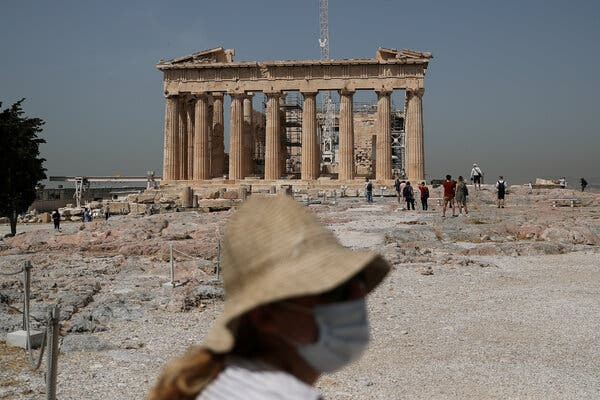
European leaders, deeply concerned that another summer’s lucrative tourism trade could be lost to the pandemic, are escalating calls for the European Union to introduce a common system that would allow borders to reopen to people who have been inoculated against the virus.
Even as Europe’s vaccination program contends with long delays and one senior European Union official admitting it would be “difficult” to reach the bloc’s goal of vaccinating 70 percent of adults by the end of summer, the idea of a European Union-wide vaccine passport system has become a hotly discussed topic.
Senior officials in Greece and Spain — countries heavily reliant on tourism — are among those who have supported proposals for a program of so-called vaccine passports.
They argue that requiring people to show a certificate proving they have received a coronavirus shot would restore the bloc’s pillar of free movement, help draw in summer holidaymakers and allow business trips to return.
Before a scheduled online meeting on Thursday of the heads of all 27 European Union nations, the Austrian chancellor, Sebastian Kurz, added his voice in support of the idea.
“We want to get back to normal as quickly as possible, have our old lives back and maximum freedom,” Mr. Kurz said in a tweet on Wednesday. “We therefore want an EU-wide Green Passport, with which people can travel freely, do business without restrictions and go on holiday, as well as finally enjoy gastronomy, culture, events and other things again.”
But there is concern brewing that introducing a vaccine passport system so early in Europe’s vaccination program would create a two-tier system by the summer of inoculated people who could travel carefree while those yet to be vaccinated would be grounded.
European leaders are not expected to make a decision at the summit meeting on Thursday on the use of vaccination certificates, but they are expected to discuss how to ensure such a program would be able to run across all countries in the bloc.
In an interview with Bild Live, a digital offshoot of the German tabloid, Mr. Kurz urged that the passport system to be one easily accessible on a cellphone.
He said he supported the idea “so everyone can have all the freedoms back that we value so much,” adding that he was “personally very optimistic about the summer.”

Federal regulators on Thursday approved a request by Pfizer and BioNTech to store and transport their vaccine at standard freezer temperatures instead of in ultracold conditions, potentially expanding the number of sites that can administer shots.
The Food and Drug Administration said the change allowed for “more flexible conditions.”
“The alternative temperature for transportation and storage will help ease the burden of procuring ultralow cold storage equipment for vaccination sites and should help to get vaccine to more sites,” Dr. Peter Marks, director of the F.D.A.’s Center for Biologics Evaluation and Research, said in a statement.
Now, smaller pharmacies and doctors’ offices should be able to administer shots, since they can use their existing refrigerators or freezers.
Until now, distribution of the Pfzier-BioNTech vaccine has been complicated by the requirement that the vaccine be stored in freezers that kept it between -112 and -76 degrees Fahrenheit. But last week, the companies submitted new data to the F.D.A. showing their vaccine could be safely stored at -13 to 5 degrees Fahrenheit for up to two weeks.
Moderna’s vaccine can be stored in standard freezers and then in a refrigerator for up to 30 days. That has allowed it to be used more readily at smaller vaccination sites.
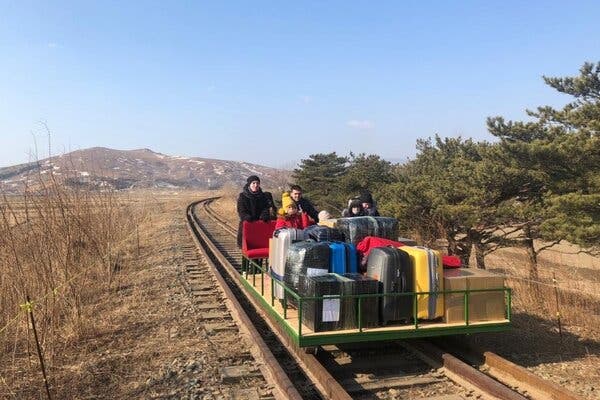
North Korea sealed its borders more than a year ago, grounding flights and shutting its borders with neighboring China and Russia because of the pandemic.
This week, a few Russians found a way out.
Russia’s Foreign Ministry said on Thursday that several employees at its embassy in North Korea had taken an unusual route — one that included a bus ride and a trip on a hand-pushed railroad trolley — to reach the country’s border with Russia.
The group included the embassy’s third secretary, Vladislav Sorokin, and his 3-year-old daughter, the ministry said on its official Facebook page. It also posted a photograph showing several children sitting on the trolley beside suitcases, with adults walking behind them on a railroad track and snow-capped hills in the distance.
When the group arrived at a Russian border post in Siberia, they were meet by colleagues from the Foreign Ministry and taken to an airport in Vladivostok, the ministry’s post said.
It was not clear from the post whether the group had broken any North Korean regulations or encountered any police or border officials. The ministry did not immediately respond to an email on Friday requesting further details about the journey.
North Korea closed its borders in January 2020 out of fears that a Covid-19 outbreak could seriously test its underequipped public health system and a domestic economy that was already struggling under international sanctions, analysts say.
The country has also deployed crack troops along its border with China with “shoot to kill” orders to prevent smugglers from bringing in the coronavirus, Gen. Robert B. Abrams, commander of the United States military in South Korea, said in September.
The North’s leader, Kim Jong-un, said last summer that he would not accept international aid after devastating floods in his country for fear that outside help might bring in the virus, the state news media reported.
But Mr. Kim is apparently willing to import Covid-19 vaccines. According to a report this month by Covax, an international group that has negotiated for vaccine doses, North Korea is expected to receive nearly two million doses of the AstraZeneca shot by the middle of this year.
The North’s state news media has long insisted that the country has no confirmed Covid-19 cases, but outside experts are skeptical.

The prime minister of France said Thursday that several regions could face new pandemic restrictions starting March 6, as the country recorded a sharp increase in Covid-19 infections.
“The virus has been gaining ground again in the past week,” Prime Minister Jean Castex told reporters at a news conference, adding that the surge in infections was attributable to new variants of the virus, such as one originally detected in Britain that now accounts for half of infections in France.
France on Wednesday registered more than 30,000 new coronavirus cases, up from a daily average of 20,000 new infections in recent weeks and the biggest daily tally since mid-November.
Mr. Castex said that 20 of the country’s administrative regions would be put on alert and that stricter limits on movement would be enforced there if infections rise further in the coming week. The regions include the Paris area and the northern and southern tips of the country.
Restrictions could include weekend lockdowns, increased checks at airports and a crackdown on public gatherings in public places, similar to measures that were recently enforced on the French Riviera and in the city of Dunkirk, Mr. Castex said.
Unlike some of its neighbors, France has resisted imposing a new national lockdown to fight back the more contagious variants, instead opting for restrictions at the regional level.
Reacting to the news, Paris’s deputy mayor Emmanuel Grégoire said such measures would not be enough to fight back rising infections. Instead, he suggested a total lockdown of the capital for three weeks so the city would “have the possibility to reopen everything” afterward, including bars, restaurants and cultural venues.
Mr. Castex said that by mid-May, everyone over 50 should have received a first Covid-19 vaccine dose. With about 4 percent of its total population, or 2.7 million people, having received a first dose, France trails countries like the United States, the United Kingdom and Israel but is on par with its Spanish and German neighbors.
“Everything possible must be done to delay” a new national lockdown, Mr. Castex said. He added that tightening restrictions just enough to stave off a new surge of the virus without affecting businesses and people’s lives too much was a “difficult balance” to strike.
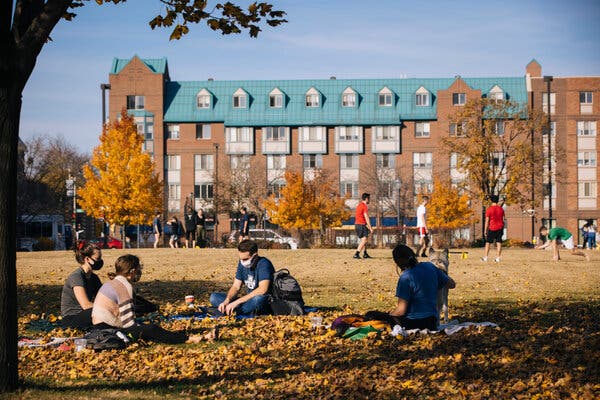
Coronavirus cases have continued to emerge by the tens of thousands this year at colleges, a New York Times survey found, after students returned to campuses during a period when case numbers were soaring across much of the country.
More than 120,000 cases have been linked to American colleges and universities since Jan. 1, and more than 530,000 cases have been reported since the beginning of the pandemic. The Times also identified more than 100 deaths involving college students and employees. The vast majority occurred in 2020 and involved employees.
Nearly a year after most universities abruptly shifted classes online and sent students home, the virus continues to upend American higher education. When many campuses reopened in the fall, outbreaks raced through dorms and infected thousands of students and employees.
Since students returned for the spring term, increased testing, social distancing rules and an improving national outlook have helped curb the spread on some campuses. At Ohio State, where the test positivity rate once peaked at about 5 percent, university officials reported a positivity rate of just 0.5 percent across 30,000 tests on campus in one recent week.
Still, major outbreaks continue.
The Times surveyed more than 1,900 colleges and universities for coronavirus information and found at least 17 colleges have already reported more than 1,000 cases in 2021. At the University of Michigan, a highly infectious variant turned up on campus. At the University of Massachusetts Amherst, where more cases have been identified in 2021 than during the fall term, in-person classes are resuming after a difficult start to the year.
Kumble R. Subbaswamy, the chancellor at Massachusetts, wrote in a letter to the university community last week of a “promising but fragile opportunity” to resume campus life, warning that “we stand at a critical juncture of the spring semester.”
Despite surges at some colleges, there are positive signs. In counties with large populations of college students, coronavirus cases have been falling, mirroring a national trend in declining cases.
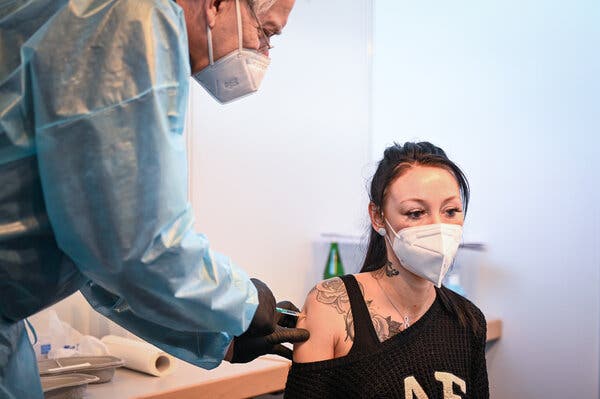
BERLIN — A preference for the vaccine developed by the German company BioNTech with Pfizer is causing a surplus in Germany of the shot developed by AstraZeneca, a British-Swedish company, according to state health officials.
Many people — including health workers — are skipping appointments or refusing to sign up for the AstraZeneca shot, which they fear is less effective than the Pfizer-BioNTech vaccine, the officials say. As a result, two weeks after the first delivery of 1.45 million doses of the AstraZeneca vaccine arrived in Germany, only 270,986 have been administered, according to data collected by the public health authority.
“Vaccinating fast is the order of the day,” Germany’s president, Frank-Walter Steinmeier, said Thursday during a videoconference in Bavaria, stressing that all three vaccines in use in Germany had been approved by the European Medicines Agency and were trustworthy.
“I personally have little sympathy for the reluctance to use one vaccine or another,” he said. “This is a first-world problem, certainly for those who are still waiting for their first vaccination and even more so for people in countries who might not even have the prospect of receiving a first inoculation this year.”
The rejection of the AstraZeneca vaccine has been fueled by weeks of negative coverage about it in the German media, which has portrayed it as “second-class,” citing its lower efficacy rate compared with the Pfizer-BioNTech vaccine and reporting stories of people suffering adverse reactions.
Clinical trials do suggest that Pfizer’s efficacy, at 95 percent, is higher than AstraZeneca’s, which is between 60 and 90 percent depending on factors such as the spacing of doses. Still, it is difficult to directly compare shots unless they are tested head-to-head in the same trial. And many health professionals suggest getting whichever vaccine is available first, since Covid-19 poses such significant health risks.
Widespread skepticism in Germany about vaccines has exacerbated people’s reluctance to take the AstraZeneca shot. Medical and other frontline workers have also expressed resentment about being given unused AstraZeneca shots, instead of the Pfizer-BioNTech one, saying it showed a lack of respect after their efforts to help the country fight the pandemic over the past year.
The rejection of the AstraZeneca vaccine has caused delays in a mass vaccination campaign that was already struggling with bureaucratic and logistical hurdles. That has raised concerns that failure to immunize people quickly enough could stymie efforts to return the country to normal life, as new coronavirus infections are increasing even as Germany remains largely locked down.
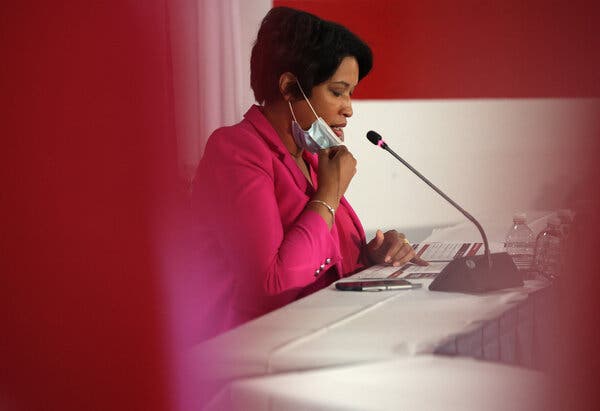
As the coronavirus death toll in Washington, D.C., reached 1,000, Mayor Muriel E. Bowser declared that Wednesday would be “a day of remembrance for lives lost” to the virus.
“Most importantly,” she said in the proclamation, “these 1,000 beautiful souls who passed were our parents, children, cousins, neighbors, classmates, colleagues, friends, and our cherished loved ones.”
By that afternoon, Ms. Bowser was announcing that the milestone had become even more personal: Her sister was among those who had died.
Mercia Bowser, whom the mayor said had helped people with behavioral disorders, children and older people while working for Catholic Charities and the city’s Office on Aging, had died on Wednesday morning of “complications related to Covid-19.” She had been treated for pneumonia related to the virus at MedStar Washington Hospital Center, the mayor said.
The death of Ms. Bowser’s only sister was the latest reminder that the virus has been unsparing as it has killed more than 500,000 people and spread from nursing homes to grocery stores to the White House and through other halls of government. And it was also another sign of just how severe and disproportionate the virus’s impact has been on Black people, who make up 46 percent of Washington’s residents but 75 percent of the city’s Covid-19 deaths.
“Mercia was loved immensely and will be missed greatly, as she joins the legion of angels who have gone home too soon due to the pandemic,” Ms. Bowser said in a statement, in which she asked for privacy as she and her family mourned. Mercia Bowser is survived by both of her parents, Joan and Joseph Bowser, as well as several brothers, nieces and nephews.
The mayor said her sister, who was 16 years older than she is, was her oldest sibling. She said she would soon share more about how her family would be honoring her.
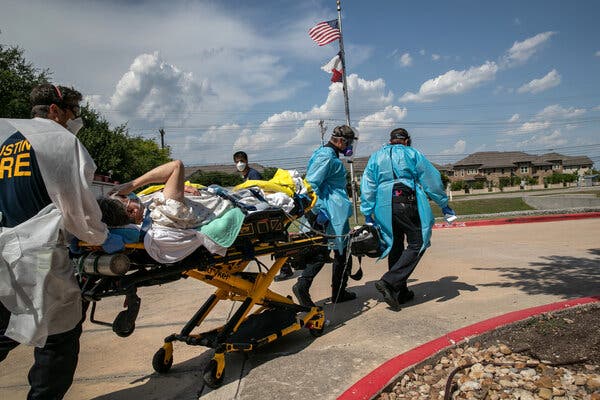
Contagion and death have been intertwined with nursing homes since the coronavirus made its first appearance in the United States.
Some of the grimmest chapters in the book of death the pandemic has written over the past year have been set in the very places where the weakest Americans were meant to be sheltered.
The virus has raced through some 31,000 long-term care facilities, killing more than 163,000 residents and employees. They accounting for more than a third of all virus deaths since the late spring.
But something is changing.
Our graphics team has taken a look at nursing home deaths and found heartening news.
Since the arrival of vaccines, which were prioritized to long-term care facilities starting in late December, new cases and deaths in nursing homes have fallen steeply, outpacing national declines, according to a New York Times analysis of federal data.
The turnaround is an encouraging sign for vaccine effectiveness and offers an early glimpse at what may be in store for the rest of the country, as more and more people get vaccinated.
transcript
0:00/1:30
–0:00
transcript
Officials Monitoring New Variant Detected in N.Y.C.
New York City officials said on Thursday that they are investigating possible risks of a new coronavirus variant spreading in the city, but that it did not appear yet to require change in public health response.
-
“So right now, at least for the report that we hear — we have from Columbia — we need to just consider this a variant of interest, something that’s interesting that we need to follow and track. But it doesn’t change anything about our public health concern. We need more data and studies to understand that. So we are able to detect and track this new strain that’s been reported, and we’ll continue to follow it. We have the ability also to now collect information about those patients, and to understand better whether or not they have different features or outcomes. And through our test and trace score, which is the best performing test and trace score in the country, has the ability to offer. You know, if somebody was infected, did they spread it to other people more often than something else.” “Because I understand when people hear variant it is a cause for concern, of course. And there’s something about it that’s unknown, and that gets people worried. I don’t blame anyone who’s feeling that way. But I want to really take the essence of what Dr. Varma is saying here: Until there’s evidence that tells us that a variant is not handled well by vaccine, for example, or a variant has different impacts, we shouldn’t assume the worst. We should say we need the full truth. We need the facts because so far the experience with the variants has been, even where there’s been some proof of being more transmissible for example, and it’s not changed the reality, it’s not changed the impact of the disease, it’s not changed our ability to fight the disease with the vaccine and all the other measures we take.”
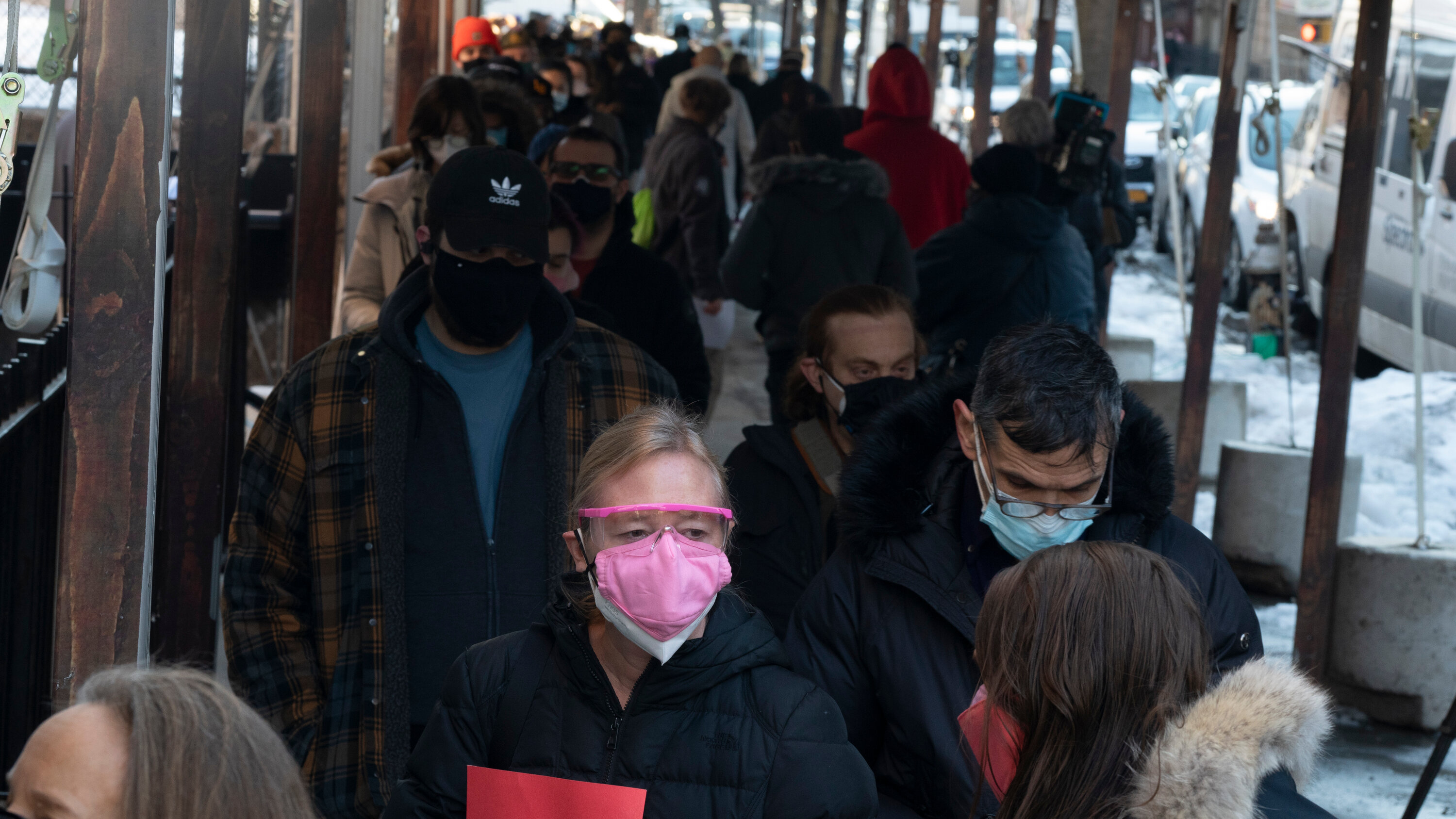
New York City officials said on Thursday that the full possible risks posed by a new form of the coronavirus spreading in New York City were unknown, but that it did not appear yet to require that the city modify its public health response.
Two teams of researchers have reported that the new virus variant carries a worrisome mutation that may weaken the effectiveness of vaccines.
Right now, “we need to just consider this a variant of interest — something that’s interesting, that we need to follow and track,” Dr. Jay Varma, the mayor’s senior adviser for public health, said at a news conference with Mayor Bill de Blasio.
“But it doesn’t change anything about our public health concern,” he added. “We need more data and studies to understand that.”
Public health officials have also been working “incredibly intensively” to improve efforts to detect new variants as a whole, Dr. Varma added.
The new variant, called B.1.526, first appeared in samples collected in the city in November. By the middle of this month, it accounted for about one in four viral sequences appearing in a database shared by scientists.
Asked about the new variant on NBC’s “Today,” Dr. Anthony S. Fauci, the nation’s leading expert on infectious diseases, said any new version of the virus is a concern, and he urged people to get vaccinated to stop it from spreading.
“Other strains or mutants or variants, as we call them, are coming up, but the major spread in the country right now — the vaccine is good against it,” he said. “And even ones in which it may be somewhat less effective, the vaccine is still good against severe disease.”
One study of the new variant found in New York City, led by a group at Caltech, was posted online on Tuesday. The other, by researchers at Columbia University, was published on Thursday morning. Neither study has been peer-reviewed or published in a scientific journal.
Dr. Dave A. Chokshi, the city’s health commissioner, said on Thursday that officials had no evidence that the B.1.526 variant was concentrated in specific areas or contributing to the broader spread of the virus in the city.
The variant carries a mutation, shared with other variants discovered in Brazil and South Africa, that partially blunts the body’s immune response. The authorized vaccines are still effective, scientists say. But now Moderna and Pfizer-BioNTech are examining whether third booster shots may be necessary to counter new variants as they arise.
The new variant “is not particularly happy news,” said Michel Nussenzweig, an immunologist at Rockefeller University who was not involved in the new research. “But just knowing about it is good because then we can perhaps do something about it.”
Dr. Nussenzweig said he was more worried about the variant in New York than the one quickly spreading in California.
Since the peak of the holiday surge in early January, New York City has seen a steep decline in the number of people testing positive for the coronavirus each day, as have the state and the nation. But the drop has not been as dramatic as it has been nationally, and community transmission in the city remains high, with about 3,200 probable and confirmed new cases reported daily. As more contagious variants spread, the city’s positive test rate has only dropped slowly, to over 7.1 percent this week from 8 percent two weeks ago, according to city data.
Yet another variant, discovered in Britain, now accounts for about 2,000 cases in 45 states. It is expected to become the most prevalent form of the coronavirus in the United States by the end of March.
Patients infected with virus carrying that mutation were about six years older on average and more likely to have been hospitalized. While the majority of patients were found in neighborhoods close to the hospital — particularly Washington Heights and Inwood — there were several other cases scattered throughout the metropolitan area, said Dr. David Ho, director of the Aaron Diamond AIDS Research Center at Columbia University.
“We see cases in Westchester, in the Bronx and Queens, the lower part of Manhattan and in Brooklyn,” Dr. Ho said. “So it seems to be widespread. It’s not a single outbreak.”
Still, some experts remained optimistic about the fight to control the spread of the disease, now that a number of vaccines are being distributed.
As the virus continues to evolve, the vaccines may need to be tweaked, “but in the scheme of things, those aren’t huge worries compared to not having a vaccine,” said Andrew Read, an evolutionary microbiologist at Penn State University. “I’d say the glass is three-quarters full, compared to where we were last year.”
On the “Today” show, Dr. Fauci said the new findings underscore the need for Americans to get vaccinated as quickly as possible.
“When a vaccine becomes available, take it,” he said. “The longer one waits not getting vaccinated, the better chance the virus has to get a variant or a mutation.”
Eileen Sullivan and Sharon Otterman contributed reporting.
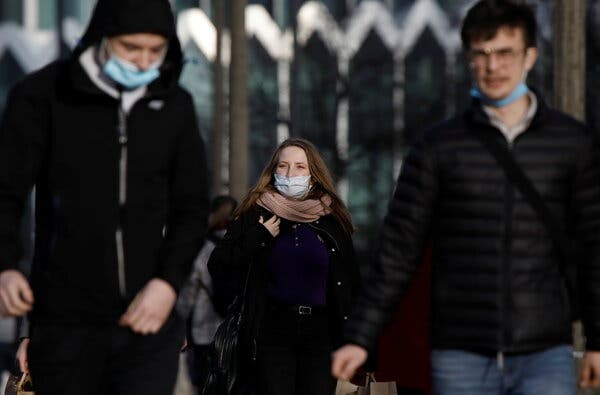
With many businesses in Poland in open revolt against coronavirus restrictions — and their cause increasingly backed by the court — the Polish government is hoping to blunt a recent rise in cases by turning to the one tool known to work: masks.
The Polish government announced this week that face coverings like scarves and bandannas can no longer be worn instead of protective masks.
The announcement came as the number of new cases rose for a second straight day — with some 12,000 new infections detected on Wednesday.
“The third wave of the epidemic is gaining momentum,” said the Polish health minister, Adam Niedzielski, during a news conference on Wednesday.
He also said that restrictions would be tightened in the Northeastern region of the country where the growth in cases has been highest.
Children in early primary school will be forced to return to remote learning and galleries, museums, swimming pools, movie theaters and hotels will have to close down again — less than two weeks after they were allowed to reopen.
The minister, who is currently self-isolating after coming into contact with a virus-infected member of the government during a news conference last Friday, announced additional restrictions on the Polish southern border with Slovakia and the Czech Republic.
Both of those neighboring countries have seen even larger surges in new cases and nearly all people entering Poland from those nations will have to present proof of a negative coronavirus test or proof of complete vaccination.
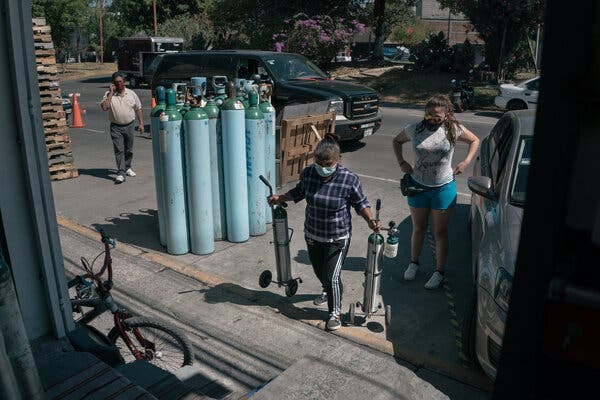
The World Health Organization on Thursday warned that as many as 20 poor countries were in urgent need of oxygen, as more than 500,000 Covid-19 patients in low and middle income countries around the world need an oxygen treatment each day.
Access to oxygen has always been difficult for some countries, and the pandemic has exacerbated the problem, leading to deaths that might have otherwise been avoided, the global health organization said.
In Mexico, hospitals have been so overrun that virus patients have been dying in their homes, gasping for air because there are not enough oxygen tanks to meet the need. In Egypt, patients died last month at a hospital because of an interruption in oxygen supplies.
Last month in the northern Brazilian state of Amazonas, patients died of asphyxiation because hospitals ran out of oxygen amid a sharp rise in critically ill patients. The director of the country’s health regulatory agency, Alex Machado Campos, called the oxygen shortage the “saddest and most outrageous expression of the government’s abject failure at all levels.”
The W.H.O. created an emergency task force to address the shortages. The group identified countries that were in immediate need, including Afghanistan, Malawi and Nigeria, and said it would cost $90 million to address the most urgent needs. The task force estimates it will cost $1.6 billion over the next 12 months to address the global oxygen shortages in the short run.
“Many of the countries seeing this demand struggled before the pandemic to meet their daily oxygen needs,” said Dr. Philippe Duneton, the executive director of Unitaid, a Geneva-based global health agency that pledged to help fund the emergency response.
“Now it’s more vital than ever that we come together to build on the work that has already been done, with a firm commitment to helping the worst-affected countries as quickly as possible,” he said.
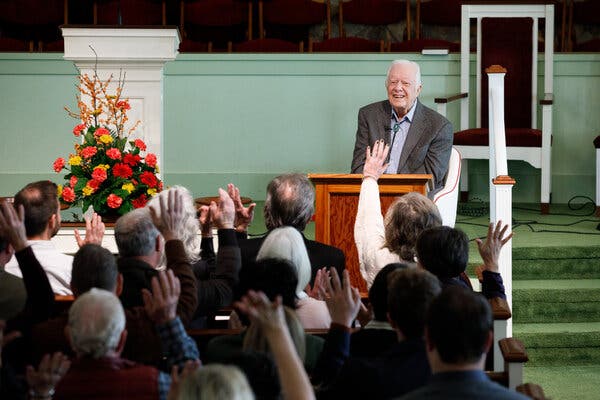
The list of announcements at the Maranatha Baptist Church in Plains, Ga., on Sunday included some routine business. There was a reminder of a deacons’ meeting immediately following the service and a request for donations of macaroni and cheese for a local food bank.
Then the pastor said he had one additional announcement to share, and it was good news: Jimmy and Rosalynn Carter were back.
The former president, 96, and his wife, 93, had returned to the church to worship in person for the second Sunday in a row, now that both had received vaccinations against the coronavirus, the pastor, Tony Lowden, said.
“Let’s welcome them back,” Pastor Lowden told the congregation, according to a video of the service posted on the church’s Facebook page. The Carters, wearing masks, waved from their familiar spot in the front pew, acknowledging applause from the church.
Pastor Lowden gently reminded the members that if they “get tackled” by the Secret Service when approaching the Carters, it would only be because the church was practicing social distancing.
The Carters have long been devoted members of Maranatha Baptist — she as a deacon, and he as a deacon and, for many years, a Sunday school teacher.
The Sunday school classes, which he no longer teaches, for decades drew Democratic presidential candidates and visitors from across the country, who made pilgrimages to hear the former president teach at the church in the tiny southwest Georgia farming community where he was raised.
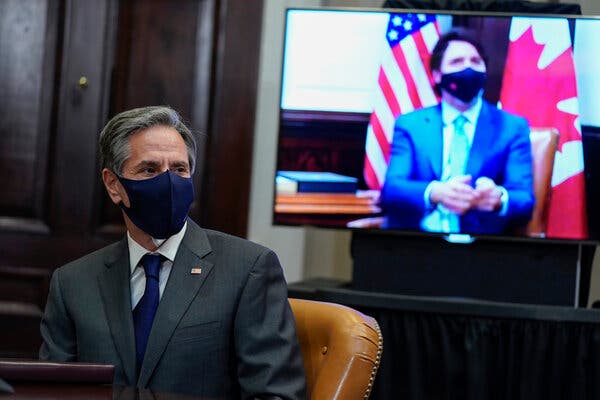
Secretary of State Antony J. Blinken plans to take virtual “trips” to Mexico and Canada on Friday, an effort to continue diplomacy in as normal a fashion as possible at a time when the coronavirus has shut down most foreign travel.
Mr. Blinken will first “visit” Mexico, the State Department announced in a statement on Thursday, where he will meet with Secretary of Foreign Affairs Marcelo Ebrard and Secretary of Economy Tatiana Clouthier to discuss issues like trade, migration and climate change. Mr. Blinken and Mr. Ebrard will also pay a joint virtual visit to the Del Norte border entry point to discuss management of the southern U.S. border.
The digital facsimile of travel is an innovative, if potentially awkward, effort by the State Department to compensate for Mr. Blinken’s inability for now to take physical trips amid the pandemic, a frustrating condition for a newly installed diplomat determined to rebuild U.S. alliances after the Trump era.
“We’re trying to make it resemble, as closely as we can, a physical trip,” said Ned Price, a State Department spokesman.
Mr. Blinken has been vaccinated, but State Department officials say that given the size of his overseas entourage, and potential risks to people who might gather for his visits in host countries, he is not expected to take a physical trip before late March at the earliest.
Later on Friday, Mr. Blinken will meet with Canadian officials, according to the State Department, including Prime Minister Justin Trudeau and Foreign Minister Marc Garneau, as well as a group of Canadian students.
Mr. Blinken’s meeting with the students, visit to the border, and “meet and greets” with embassy employees are intended to replicate the sort of interactions with host countries outside of government ministries that enrich diplomatic travel but have become dangerous because of the virus.
Mr. Blinken joined President Biden on Tuesday for a virtual meeting with Mr. Trudeau, who was broadcast onto a large video screen about 20 feet away from his American hosts, and then appeared on another screen alongside Mr. Biden, standing at a podium, for press statements.
As Julie Chung, the acting assistant secretary of state for Western Hemisphere affairs, put it in a briefing for reporters Thursday: “This is the new world we live in.”

